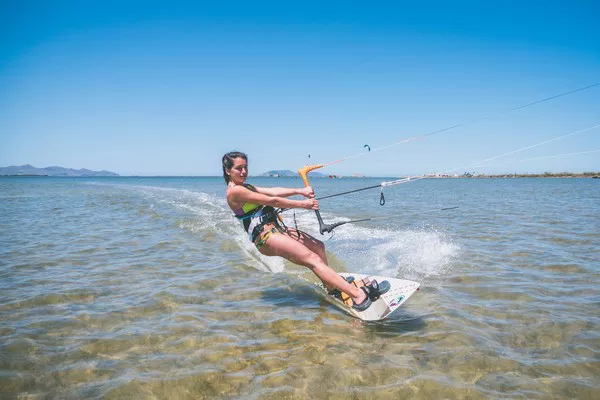Kitesurfing, a thrilling blend of kite flying and surfing, allows riders to harness the power of the wind to glide across the water’s surface. One of the essential skills for any kitesurfer to learn is how to ride upwind effectively. Mastery of upwind kitesurfing not only expands your range and exploration possibilities on the water but also enhances safety by giving you more control over your kite and board. In this comprehensive guide, we will delve into the techniques and strategies required to conquer upwind riding like a pro.
Understanding the Basics
Before diving into the specifics of upwind riding, it’s crucial to grasp the fundamental concepts of kite control and board positioning. Kitesurfing relies heavily on the wind’s power, which propels the kite and pulls the rider along the water’s surface. To start, ensure you have a good grasp of basic kite control—managing the kite’s power, steering, and generating sufficient lift for movement.
Choosing the Right Equipment
Having the appropriate gear is essential for successful upwind kitesurfing. A board with good upwind performance, such as a twin-tip or directional board, can make a significant difference. Twin-tip boards are symmetrical and easy to ride, while directional boards are better suited for advanced riders seeking optimal upwind angles.
Additionally, the kite size plays a crucial role. Opt for a kite that provides enough power without being overwhelming. A smaller kite can generate more power per square meter, allowing for better upwind performance in stronger winds.
Body Position and Board Edging
Achieving good upwind progress relies on proper body positioning and board control. Begin by edging your board against the kite’s pull. To do this, shift your weight slightly back and press your heels down on the edge of the board. This technique creates resistance against the water, allowing you to move upwind more effectively.
Maintain a balanced stance with your knees slightly bent and your weight centered over the board. Keep your shoulders aligned with your hips and maintain a firm grip on the control bar to steer the kite efficiently.
Efficient Kite Control
To ride upwind successfully, you must master efficient kite control. Practice flying the kite in a figure-eight pattern to generate consistent power and lift. Keep the kite at a steady angle—too high, and you’ll lose power; too low, and you risk diving into the water.
As you ride, periodically adjust the kite’s position to optimize power and speed. By flying the kite actively, you can generate more lift and maintain forward momentum, crucial for making progress upwind.
Tacking and Body Positioning
Tacking, or zigzagging upwind, is a key technique in upwind kitesurfing. To tack effectively, angle your board slightly upwind and sail towards the wind. As you approach a close-hauled course, shift your weight slightly back and push against the water with your back foot to initiate the turn.
During the tack, maintain tension in the lines and keep the kite steady in the sky. As you complete the turn, shift your weight to the new upwind rail and edge the board to resume your upwind course.
Building Wind Awareness
Understanding wind patterns and conditions is crucial for upwind kitesurfing. Pay close attention to wind direction and strength. Take note of gusts and lulls, adjusting your kite’s position and riding style accordingly.
Practice reading wind shifts and adapting your technique to maximize efficiency. Over time, you’ll develop a keen sense of wind awareness, allowing you to anticipate changes and optimize your upwind riding technique.
Harnessing the Wind’s Power
Upwind kitesurfing is all about harnessing the wind’s power efficiently. By riding at an angle to the wind, you can use the kite’s lift and the board’s resistance to propel yourself upwind. Experiment with different angles and board positions to find the optimal balance between speed and upwind progress.
Advanced Techniques for Upwind Riding
Once you’ve mastered the basics, consider exploring advanced techniques to enhance your upwind kitesurfing skills:
- Power Strokes: Use short, powerful strokes with your kite to generate extra lift and speed.
- Body Positioning: Experiment with your body position to optimize aerodynamics and reduce drag.
- Board Upwind Carving: Practice carving upwind by shifting your weight and edging the board effectively.
- Footwork: Experiment with foot positioning and weight distribution for precise control and maneuverability.
Safety Considerations
As with any watersport, safety should always be a top priority. Before attempting upwind kitesurfing, ensure you have sufficient experience and confidence in basic kite control and riding techniques. Always wear appropriate safety gear, including a helmet, impact vest, and harness.
Conclusion
Mastering upwind kitesurfing opens up a world of possibilities for exploration and adventure on the water. By refining your kite control, body positioning, and board edging techniques, you can ride upwind with confidence and efficiency. Remember to practice regularly and stay attuned to wind conditions to continuously improve your skills. With dedication and perseverance, you’ll soon be gliding effortlessly upwind like a seasoned kitesurfing pro.

